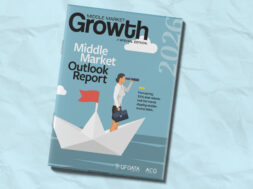Highest Multiples Seen in Decades Keep Mid-Market Dealmakers Optimistic
Middle-market dealmakers anticipate another banner year, even as Russia’s invasion of Ukraine throws uncertainty into the mix, says GF Data's B. Graeme Frazier.

The numbers don’t lie: 2021 was a banner year for middle-market private equity dealmaking, with momentum carrying through the end of December and into the new year. That inertia hasn’t diminished as analysts continue to view 2022’s M&A landscape as a seller’s market.
GF Data, which offers valuation data on private-equity sponsored M&A across the middle market, recently published its analysis of 2021’s end-of-year frenzy. According to GF Data co-founder and principal B. Graeme Frazier, that momentum is almost certainly carrying into 2022.
“This story is almost more about the deals that aren’t getting done,” he says.
Yet economic uncertainty remains a constant even through periods of growth and resiliency.
On the day Frazier spoke with Middle Market Growth, Vladimir Putin’s Russia invaded and attacked Ukraine. Against this backdrop, Frazier says, perhaps the only thing certain within the middle market today is that nothing is certain.
(Still) a Seller’s Market
Analyzing the 151 transactions that occurred in Q4 of 2021 across its 258 active private equity contributors, GF Data drew clear conclusions about the state of M&A at the close of 2021. Valuations and premiums are high, and with plenty of available funding to disburse, dealmaking is headed for another strong year.
Frazier points to GF Data’s findings that multiples for middle-market deals averaged 7.5x EBITDA for Q4, in line with multiples reported for Q3 and marking “some of the highest average multiples we’ve seen in publishing data going back to 2003,” he notes.
GF Data found that among middle-market companies (defined by the firm as businesses with a total enterprise value of between $10 million and $250 million), there is room for valuations to continue to rise into 2022 thanks to the robust availability of debt.
“We haven’t historically had more than, on average, 55% of debt in the capital structure,” Frazier says, “but in 2021 Q4 we saw about 52%. So, It looks like there’s potentially a little room to move valuations up a bit, especially on deals that are on the smaller side of our data set—under $100 million—or even under $50 million of enterprise value.”
Paying a Premium
While these generalizations don’t apply to every middle-market business engaging in M&A activity, the data points to the strength of some industries that are enjoying higher multiples.
Frazier highlights healthcare, business services and distribution (notwithstanding supply chain disruptions) as spaces in which companies operate with lighter balance sheets that were able to bounce back more quickly amid the pandemic, compared with businesses with heavier balance sheets.
“For manufacturing businesses, and more balance sheet-heavy businesses, it’s taken longer for the comparisons post-COVID to work themselves through,” he says. “Asset-light businesses can rebound pretty quickly and command better valuations because they don’t have so much ‘baggage,’ whereas with the heavier-asset businesses, it takes longer for the comparisons to work their way through the system to bring their valuations back up.”
But beyond industry-specific trends, it may be more effective to look at which businesses display above-average quality.
For the deals analyzed by GF Data, all businesses met the quality test of being worthy of institutional equity capital. But when separating the highest-quality businesses from the rest of the pack, new insights emerge.
“If you have better growth and better margins, we put you in what we call ‘above-average quality,’” Frazier explains. “One thing that we’ve seen there is that the premium for those deals is about 30%, and that’s really on the high side in terms of historical, above-average premium characteristics.”
Russia Invades Ukraine
It’s definitely still a seller’s market. Now, you’re asking me this question on the day that Russia has invaded a sovereign nation in Central Europe.
B. Graeme Frazier
Principal and Co-Founder, GF Data
When asked about his outlook for the year ahead, Frazier says he remains positive, considering the context of this data. Yet there is one glaring caveat.
“It’s definitely still a seller’s market. Now, you’re asking me this question on the day that Russia has invaded a sovereign nation in Central Europe,” he says. “Exogenous events like that make changes that we can’t always predict.”
Despite the uncertainty, Frazier expects the disruption to middle-market dealmaking stemming from the attack on Ukraine to be limited, at least for the U.S.
He points to the stockpile of private equity funding yet-to-be deployed as one factor driving continued M&A optimism.
“That capital needs to get put to work,” he says. “The scarce resource is quality targets, companies that are worthy of that kind of capital to be invested in them. So I don’t see the seller’s market going away.”
Then again, he continues, if the U.S. gets pulled into a world war, the list of possible outcomes grows exponentially.


